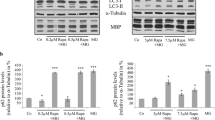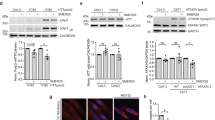Abstract
Protein aggregate formation may be the result of an impairment of the protein quality control system, e.g., the ubiquitin proteasome system (UPS) and the lysosomal autophagic pathway. For proteasomal degradation, proteins need to be covalently modified by ubiquitin and deubiquitinated before the substrates are proteolytically degraded. Deubiquitination is performed by a large family of proteases, the deubiquitinating enzymes (DUBs). DUBs display a variety of functions and their inhibition may have pathological consequences. Using the broad specificity DUB inhibitor PR-619 we previously have shown that DUB inhibition leads to an overload of ubiquitinated proteins, to protein aggregate formation and subsequent inhibition of the UPS. This study was undertaken to investigate whether PR-619 modulates autophagic functions to possibly compensate the failure of the proteasomal system. Using the oligodendroglial cell line OLN-t40 and a new oligodendroglial cell line stably expressing GFP-LC3, we show that DUB inhibition leads to the activation of autophagy and to the recruitment of LC3 and of the ubiquitin binding protein p62 to the forming aggresomes without impairing the autophagic flux. Furthermore, PR-619 induced the transport of lysosomes to the forming aggregates in a process requiring an intact microtubule network. Further stimulation of autophagy by rapamycin did not prevent PR-619 aggregate formation but rather exerted cytotoxic effects. Hence, inhibition of DUBs by PR-619 activated the autophagic pathway supporting the hypothesis that the UPS and the autophagy–lysosomal pathway are closely linked together.







Similar content being viewed by others
References
Gregersen, N. (2006). Protein misfolding disorders: Pathogenesis and intervention. Journal of Inherited Metabolic Disease, 29, 456–470.
Chin, L. S., Olzmann, J. A., & Li, L. (2010). Parkin-mediated ubiquitin signalling in aggresome formation and autophagy. Biochemical Society Transactions, 38, 144–149.
Dohm, C. P., Kermer, P., & Bahr, M. (2008). Aggregopathy in neurodegenerative diseases: Mechanisms and therapeutic implication. Neurodegenerative Diseases, 5, 321–338.
Richter-Landsberg, C., & Goldbaum, O. (2003). Stress proteins in neural cells: Functional roles in health and disease. Cellular and Molecular Life Sciences, 60, 337–349.
Schwartz, A. L., & Ciechanover, A. (2009). Targeting proteins for destruction by the ubiquitin system: Implications for human pathobiology. Annual Review of Pharmacology and Toxicology, 49, 73–96. doi:10.1146/annurev.pharmtox.051208.165340.
Jellinger, K. A. (2009). Recent advances in our understanding of neurodegeneration. Journal of Neural Transmission, 116(9), 1111–1162. doi:10.1007/s00702-009-0240-y.
Wong, E., & Cuervo, A. M. (2010). Integration of clearance mechanisms: The proteasome and autophagy. Cold Spring Harbor Perspectives in Biology, 2(12), a006734. doi:10.1101/cshperspect.a006734.
Matsuda, N., & Tanaka, K. (2010). Does impairment of the ubiquitin-proteasome system or the autophagy–lysosome pathway predispose individuals to neurodegenerative disorders such as Parkinson’s disease? Journal of Alzheimers Disease, 19(1), 1–9. doi:10.3233/JAD-2010-1231.
Huang, Q., & Figueiredo-Pereira, M. E. (2010). Ubiquitin/proteasome pathway impairment in neurodegeneration: Therapeutic implications. Apoptosis, 15, 1292–1311.
Reyes-Turcu, F. E., Ventii, K. H., & Wilkinson, K. D. (2009). Regulation and cellular roles of ubiquitin-specific deubiquitinating enzymes. Annual Review of Biochemistry, 78, 363–397.
Olzmann, J. A., & Chin, L. S. (2008). Parkin-mediated K63-linked polyubiquitination. Autophagy, 4, 85–87.
Yao, T.-P. (2010). The role of ubiquitin in autophagy-dependent protein aggregate processing. Genes Cancer, 7, 779–786.
Lamark, T., & Johansen, T. (2012). Aggrephagy: Selective disposal of protein aggregates by macroautophagy. International Journal of Cell Biology, 2012, 736905.
Tyedmers, J., Mogk, A., & Bukau, B. (2010). Cellular strategies for controlling protein aggregation. Nature Reviews Molecular Cell Biology, 11(11), 777–788. doi:10.1038/nrm2993.
Mizushima, N., Yoshimori, T., & Levine, B. (2010). Methods in mammalian autophagy research. Cell, 140, 313–326.
Klionsky, D. J., Abdalla, F. C., Abeliovich, H., Abraham, R. T., Acevedo-Arozena, A., et al. (2012). Guidelines for the use and interpretation of assays for monitoring autophagy. Autophagy, 8(4), 445–544.
Jahreiss, L., Menzies, F. M., & Rubinsztein, D. C. (2008). The itinerary of autophagosomes: From peripheral formation to kiss-and-run fusion with lysosomes. Traffic, 9(4), 574–587. doi:10.1111/j.1600-0854.2008.00701.x.
Kirkin, V., McEwan, D. G., Novak, I., & Dikic, I. (2009). A role for ubiquitin in selective autophagy. Molecular Cell, 34, 259–269.
Kraft, C., Peter, M., & Hofmann, K. (2010). Selective autophagy: Ubiquitin-mediated recognition and beyond. Nature Cell Biology, 12(9), 836–841. doi:10.1038/ncb0910-836.
Boland, B., & Nixon, R. A. (2006). Neuronal macroautophagy: From development to degeneration. Molecular Aspects of Medicine, 27(5–6), 503–519.
Klionsky, D. J. (2007). Autophagy: From phenomenology to molecular understanding in less than a decade. Nature Reviews Molecular Cell Biology, 8, 931–937.
Jaenen, S. B., Chaachouay, H., & Richter-Landsberg, C. (2010). Autophagy is activated by proteasomal inhibition and involved in aggresome clearance in cultured astrocytes. Glia, 58, 1766–1774.
Ding, W.-X., Ni, H.-M., Gao, W., Yoshimori, T., Stolz, D. B., et al. (2007). Linking of autophagy to ubiquitin-proteasome system is important for the regulation of endoplasmic reticulum stress and cell viability. American Journal of Pathology, 171(2), 513–524.
Pandey, U. B., Nie, Z., Batlevi, Y., McCray, B. A., Ritson, G. P., et al. (2007). HDAC6 rescues neurodegeneration and provides an essential link between autophagy and the UPS. Nature, 447(7146), 859–863.
Seiberlich, V., Goldbaum, O., Zhukareva, V., & Richter-Landsberg, C. (2012). The small molecule inhibitor PR-619 of deubiquitinating enzymes affects the microtubule network and causes protein aggregate formation in neural cells: Implications for neurodegenerative diseases. Biochimica Et Biophysica Acta-Molecular Cell Research, 1823, 2057–2068.
RichterLandsberg, C., & Heinrich, M. (1996). OLN-93: A new permanent oligodendroglia cell line derived from primary rat brain glial cultures. Journal of Neuroscience Research, 45(2), 161–173.
Goldbaum, O., Oppermann, M., Handschuh, M., Dabir, D., Zhang, B., et al. (2003). Proteasome inhibition stabilizes tau inclusions in oligodendroglial cells that occur after treatment with okadaic acid. Journal of Neuroscience, 23, 8872–8880.
Neuhoff, V., Philipp, K., Zimmer, H. G., & Mesecke, S. (1979). Simple, versatile, sensitive and volume-independent method for quantitative protein determination which is independent of other external influences. Hoppe-Seylers Zeitschrift Fur Physiologische Chemie, 360, 1657–1670.
Bove, J., Martinez-Vicente, M., & Vila, M. (2011). Fighting neurodegeneration with rapamycin: Mechanistic insights. Nature Reviews Neuroscience, 12(8), 437–452. doi:10.1038/nrn3068.
Amerik, A. Y., & Hochstrasser, M. (2004). Mechanism and function of deubiquitinating enzymes. Biochimica Et Biophysica Acta, 1695(1–3), 189–207.
Komander, D., Clague, M. J., & Urbe, S. (2009). Breaking the chains: Structure and function of the deubiquitinases. Nature Reviews Molecular Cell Biology, 10(8), 550–563. doi:10.1038/nrm2731.
Todi, S. V., & Paulson, H. L. (2011). Balancing act: Deubiquitinating enzymes in the nervous system. Trends in Neurosciences, 34, 370–382.
Li, Y. H., Schrodi, S., Rowland, C., Tacey, K., Catanese, J., et al. (2006). Genetic evidence for ubiquitin-specific proteases USP24 and USP40 as candidate genes for late-onset Parkinson disease. Human Mutation, 27, 1017–1023.
Proctor, C. J., Tangeman, P. J., & Ardley, H. C. (2010). Modelling the role of UCH-L1 on protein aggregation in age-related neurodegeneration. PLoS ONE, 5, 12.
Kessler, B. M., & Edelmann, M. J. (2011). PTMs in conversation: Activity and function of deubiquitinating enzymes regulated via post-translational modifications. Cell Biochemistry and Biophysics, 60, 21–38.
Vucic, D., Dixit, V. M., & Wertz, I. E. (2011). Ubiquitylation in apoptosis: A post-translational modification at the edge of life and death. Nature Reviews Molecular Cell Biology, 12, 439–452.
Ramakrishna, S., Suresh, B., & Baek, K.-H. (2011). The role of deubiquitinating enzymes in apoptosis. Cellular and Molecular Life Sciences, 68, 15–26.
Altun, M., Kramer, H. B., Willems, L. I., McDermott, J. L., Leach, C. A., et al. (2011). Activity-based chemical proteomics accelerates inhibitor development for deubiquitylating enzymes. Chemistry and Biology, 18, 1401–1412.
Kramer, H. B., Nicholson, B., Kessler, B. M., & Altun, M. (2012). Detection of ubiquitin-proteasome enzymatic activities in cells: Application of activity-based probes to inhibitor development. Biochimica Et Biophysica Acta, 1823(11), 2029–2037. doi:10.1016/j.bbamcr.2012.05.014.
Richter-Landsberg, C., & Bauer, N. G. (2004). Tau-inclusion body formation in oligodendroglia: The role of stress proteins and proteasome inhibition. International Journal of Developmental Neuroscience, 22(7), 443–451.
Fellner, L., Jellinger, K. A., Wenning, G. K., & Stefanova, N. (2011). Glial dysfunction in the pathogenesis of alpha-synucleinopathies: Emerging concepts. Acta Neuropathologica, 121(6), 675–693. doi:10.1007/s00401-011-0833-z.
Kuusisto, E., Kauppinen, T., & Alafuzoff, I. (2008). Use of p62/SQSTM1 antibodies for neuropathological diagnosis. Neuropathology and Applied Neurobiology, 34(2), 169–180.
Johansen, T., & Lamark, T. (2011). Selective autophagy mediated by autophagic adapter proteins. Autophagy, 7, 279–296.
Ichimura, Y., & Komatsu, M. (2010). Selective degradation of p62 by autophagy. Seminars in Immunopathology, 32, 431–436.
Korolchuk, V. I., Menzies, F. M., & Rubinsztein, D. C. (2010). Mechanisms of cross-talk between the ubiquitin-proteasome and autophagy–lysosome systems. FEBS Letters, 584, 1393–1398.
Kuusisto, E., Suuronen, T., & Salminen, A. (2001). Ubiquitin-binding protein p62 expression is induced during apoptosis and proteasomal inhibition in neuronal cells. Biochemical and Biophysical Research Communications, 280(1), 223–228.
Schwarz, L., Goldbaum, O., Bergmann, M., Probst-Cousin, S., & Richter-Landsberg, C. (2012). Involvement of macroautophagy in multiple system atrophy and protein aggregate formation in oligodendrocytes. Journal of Molecular Neuroscience, 47, 256–266.
Pankiv, S., Clausen, T. H., Lamark, T., Brech, A., Bruun, J.-A., et al. (2007). p62/SQSTM1 binds directly to Atg8/LC3 to facilitate degradation of ubiquitinated protein aggregates by autophagy. Journal of Biological Chemistry, 282(33), 24131–24145.
Taillebourg, E., Gregoire, I., Viargues, P., Jacomin, A. C., Thevenon, D., et al. (2012). The deubiquitinating enzyme USP36 controls selective autophagy activation by ubiquitinated proteins. Autophagy, 8, 767–779.
Berger, Z., Ravikumar, B., Menzies, F. M., Oroz, L. G., Underwood, B. R., et al. (2006). Rapamycin alleviates toxicity of different aggregate-prone proteins. Human Molecular Genetics, 15(3), 433–442.
Majumder, S., Richardson, A., Strong, R., & Oddo, S. (2011). Inducing autophagy by rapamycin before, but not after, the formation of plaques and tangles ameliorates cognitive deficits. PLoS One, 6(9), e25416. doi:10.1371/journal.pone.0025416.
Moreau, K., Luo, S., & Rubinsztein, D. C. (2010). Cytoprotective roles for autophagy. Current Opinion in Cell Biology, 22(2), 206–211. doi:10.1016/j.ceb.2009.12.002.
Ravikumar, B., Berger, Z., Vacher, C., O’Kane, C. J., & Rubinsztein, D. C. (2006). Rapamycin pre-treatment protects against apoptosis. Human Molecular Genetics, 15(7), 1209–1216.
Acknowledgments
This study was supported by the Deutsche Forschungsgemeinschaft. The expert technical help of Angelika Spanjer is gratefully acknowledged. We thank Dr. Olaf Goldbaum for helpful discussions.
Author information
Authors and Affiliations
Corresponding authors
Rights and permissions
About this article
Cite this article
Seiberlich, V., Borchert, J., Zhukareva, V. et al. Inhibition of Protein Deubiquitination by PR-619 Activates the Autophagic Pathway in OLN-t40 Oligodendroglial Cells. Cell Biochem Biophys 67, 149–160 (2013). https://doi.org/10.1007/s12013-013-9622-8
Published:
Issue Date:
DOI: https://doi.org/10.1007/s12013-013-9622-8




